Altered
Photos by David Parish
Makeup by Heather Deshea Harrison
Hair by Claudia Garcia Bouchacourt
Styling by Salvador Castañeda
Wardrobe by ALTAR’D STATE

Photos by David Parish
Makeup by Heather Deshea Harrison
Hair by Claudia Garcia Bouchacourt
Styling by Salvador Castañeda
Wardrobe by ALTAR’D STATE

For each issue of Art Avenue, we’ll highlight a speaker from the 2015 TEDxElPaso conference, which was held at the El Paso Community Foundation Room in May. An independently organized event, TEDxElPaso continues the national non-profit TED’s mission to share “ideas worth spreading.”
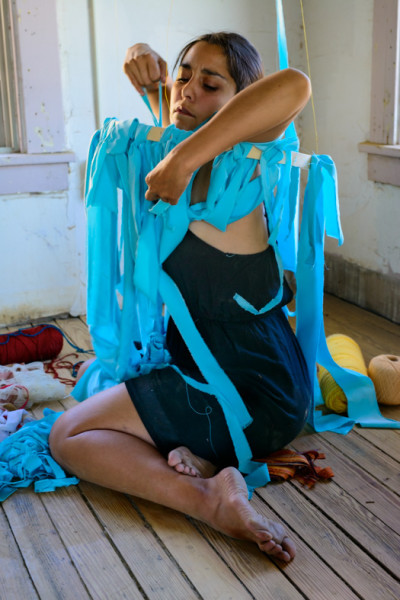
The first minute of transdisciplinary artist Xochitl Rodriguez’ time on stage during her speech “Speak Without Speaking” at the 2015 TEDxElPaso conference consisted of no words, yet a message of tranquil exploration was implied through her clothes and body movement.
Making her way towards the platform at the El Paso Community Foundation Room, Rodriguez embodied a boat as she swayed the large sail she wore from side to side. Standing in front of a video projection of the desert, she lingered on stage before speaking, her voice as calm as the sound of the gentle wind that played in the background.
“I turned myself into a boat after spending 14 months in the Kingdom of Bhutan,” Rodriguez said. “I had sailed around the planet from the desert to the Himalayas and back again.”
In 2009, after earning her BFA at the University of Texas at El Paso, Rodriguez became the first international artist in residence invited to stay in Bhutan. There, she was asked to teach children about contemporary sculpture and public art.
Of course I realized fairly quickly that my understanding of what that would entail was so far from what it actually means to teach contemporary art in the remote Himalayas,” Rodriguez said with a smile.
While one might imagine that bringing contemporary art to a country unfamiliar with the form had the biggest impact on Rodriguez, what she said she ultimately learned from the experience was a new, universal way to communicate.
“The [TedxElPaso] talk evolved from those ideas because I didn’t like to speak and I knew I could communicate in other ways that were way more effective than speaking,” Rodriguez later said at her home in central El Paso. “And now my whole artistic practice is founded on these ideas of action versus words and living examples instead of stuff you see on a wall. Everything I make is about interaction and engagement without words so that nobody is excluded.”
Bhutan is where Rodriguez’ artistic revelation came to be, she said. She learned that art, as a universal language, has the power to help people transcend physical and cultural barriers and connect with one another.
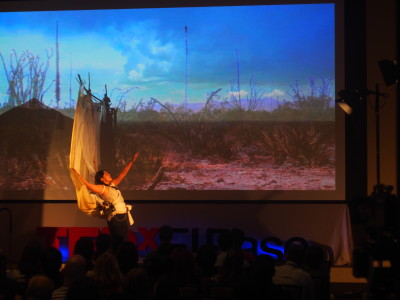
“All the world has a right to be fluent in art,” Rodriguez said during her speech. “It is in fact a language and if a community can’t access it, can’t understand it, can’t create it or generate it and most importantly can’t relate to it, then that community will not thrive, will not participate in or contribute to the very evolution of humanity in the twenty first century.”
Rodriguez’ transformative experiences emerged through every project she led with her group of Bhutanese youth. One public exhibition she led was to explore the waste generated in Bhutan.
“It took me about two weeks to realize that my students had no concept of what waste actually meant in relation to their way of life,” Rodriguez said in front of a projected image of one of Bhutan’s landfills. “And so we hopped on a bus and we hitched a ride on some dump trucks and we rode for miles and miles to the top of the mountain to the country’s largest landfill.”
Most of the children saw the garbage for what it was, but one student compared the trash to an ocean wave, sparking the idea for the group to create a boat for their exhibition. Rodriguez said a fellow artist asked if she considered that no one in Bhutan had a concept of a boat. Later, the children discovered that the neighbors filled the boat they created with trash.
“They said, ‘Certainly now madam, this boat will sink in a sea of garbage,’” Rodriguez said. “That was the moment, the unmistakable moment, when the fundamental exchange of ideas occurred. They had become translators.”
They also projected images of rice paddy fields onto Changjiji, the government housing complex in the capital city of Thimphu, as a symbol of their culture being replaced by urbanization, Rodriguez said.
Exhibiting work that everyone can connect to was another important message Rodriguez wanted to convey during her speech, she said.
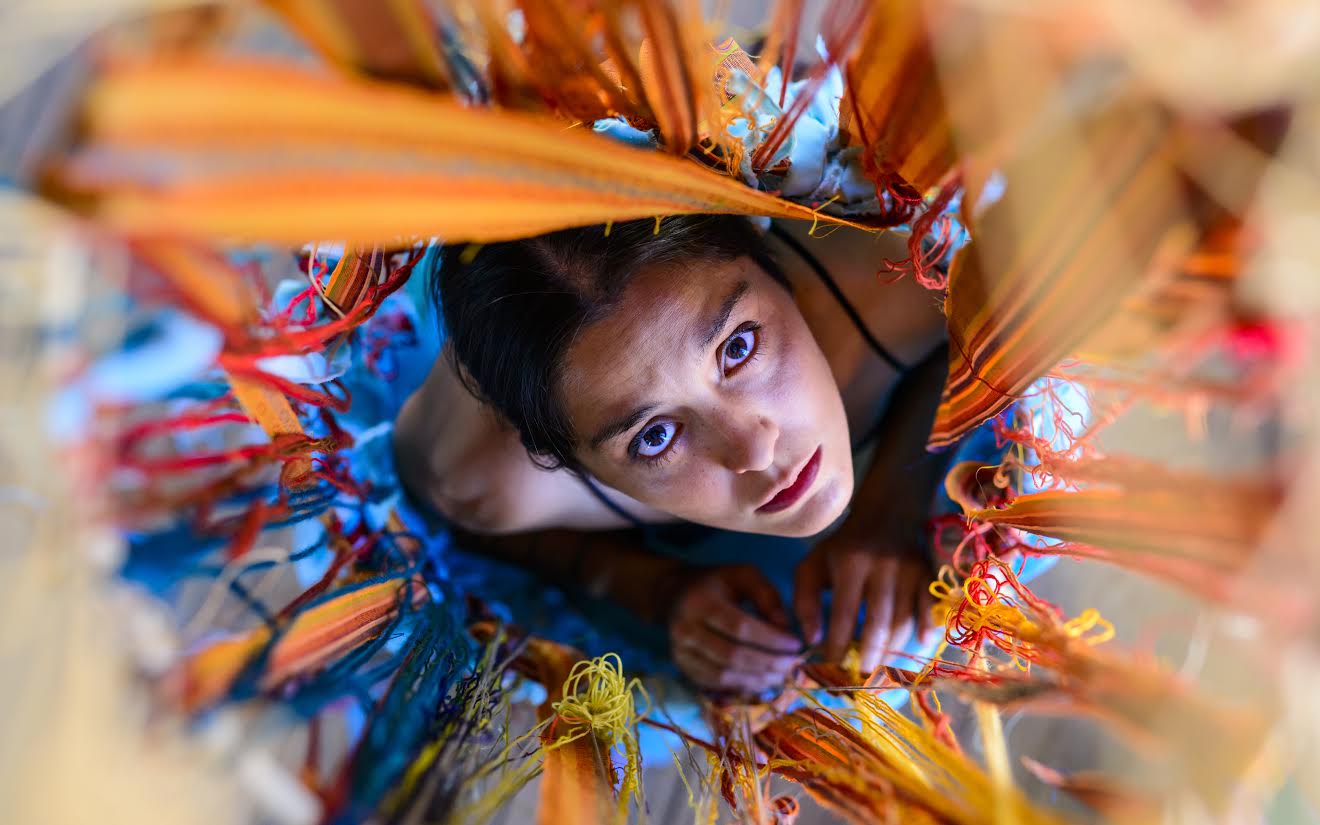
“It is a national problem where artwork isn’t made for people, but it’s made for some other audience that probably likes it, but their lives wouldn’t be changed by it,” Rodriguez later said. “You take art onto the streets and you take art to people who don’t have it and their lives would change. The whole city would change if we used art that way.”
As prayer flags danced in the wind outside her window, it was clear that a piece of the Kingdom of Bhutan would always be with Rodriguez. Talking about her experience at the small country was like ending a chapter, she said.
Her latest chapter has been a community artist collaborative she co-founded called the Caldo Collective. Every few months, a member of the collective hosts a “Frijol Feast” in which the community is invited to a dinner where several artists propose their project ideas.
From the collaborative came the Transient Triangle Project, which transformed an alleyway in Manhattan Heights into a two-hour multimedia pop-up exhibit this past July. As attendees traveled down the alley viewing video projections, interpretive performances and paintings, the exhibit echoed Rodriguez’ message at TEDxElPaso.
It’s about creating a moment in somebody’s life instead of a thing for someone,” Rodriguez said.
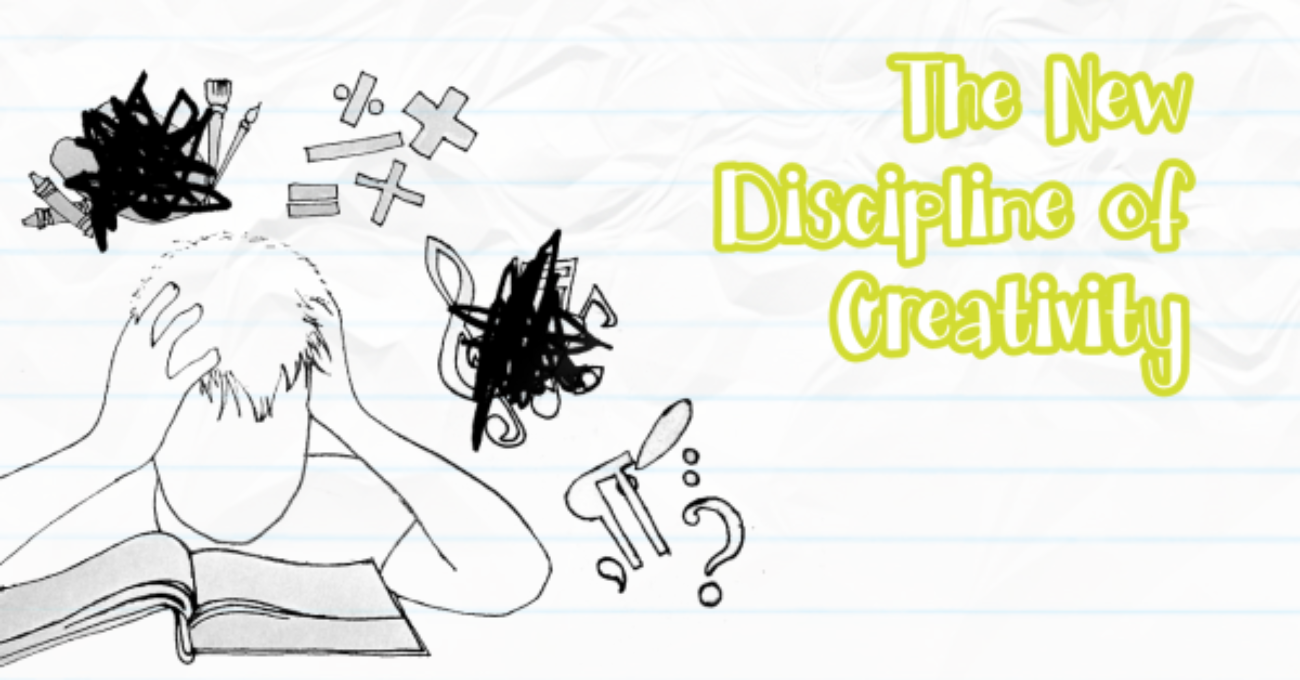
Creativity is the key to changing our public school system, says Sir Ken Robinson. The TED Talks powerhouse (he has the most-watched TED Talk, 2006’s “Do Schools Kill Creativity?”) will share his groundbreaking work on why we should totally transform public school curricula at the Plaza Theatre on Sept. 11.
Fundamental renovation of public schools is Robinson’s goal. With staggering facts, a tremendous sense of irony, and countless stories of public school failures, the British-born author argues that the optimal development of school children has been impeded, among other things, by an over-reliance on standardized testing. He will challenge El Pasoans to recognize that in the vast majority of public schools, the tremendous creative potential we are all born with has been all but ignored.

“He’s remarkable. He has the wit, the humor. He speaks with charm,” said Sally Gilbert, co-founder and director of the local non-profit Impact Programs of Excellence. “It’s hard to find somebody like that.” IPE has been working for over four years to get Robinson to El Paso. Gilbert says it was the El Paso Community Foundation that saw an opportunity for him to speak and pulled the event together. The two organizations are co-presenting Robinson’s speech, which also serves as the keynote for first annual Elevating and Celebrating Effective Teaching and Teachers El Paso, a convention model from the Bill and Melinda Gates Foundation that celebrates and promotes excellence in teaching.
“I hope that enough people understand that Sir Robinson is one of the foremost education authorities in the world,” says Eric Pearson, president and CEO of the El Paso Community Foundation. “It is so huge to have him come here.”
Robinson argues that since industrial scales and methods of production have become less central to world economies, a diploma no longer translates to getting a good job. An international advisor on education, Robinson warns that our primary and high schools are currently not designed to equip children with the knowledge and skills they need to become integral parts of thriving communities. Times have changed, and with the advent of cyberspace and other dizzying technological innovations, the creative capacity of individuals has come to be the great prize.
According to Gilbert, Impact’s rationale for bringing Robinson and many other globally-recognized speakers to El Paso is grounded in the belief that face-to-face contact with global leaders and innovators gives El Pasoans a great opportunity to learn from “people who lead, challenge, break new ground, and above all else, question.”
“He’s done so much research in different communities and all around the world, and he has so much insight,” said Gilbert.
[themify_box style=”light-green info” ]Tickets can be purchased through Ticketmaster or at The Plaza Theatre $30
September 11, 2015 7:00 pm[/themify_box]
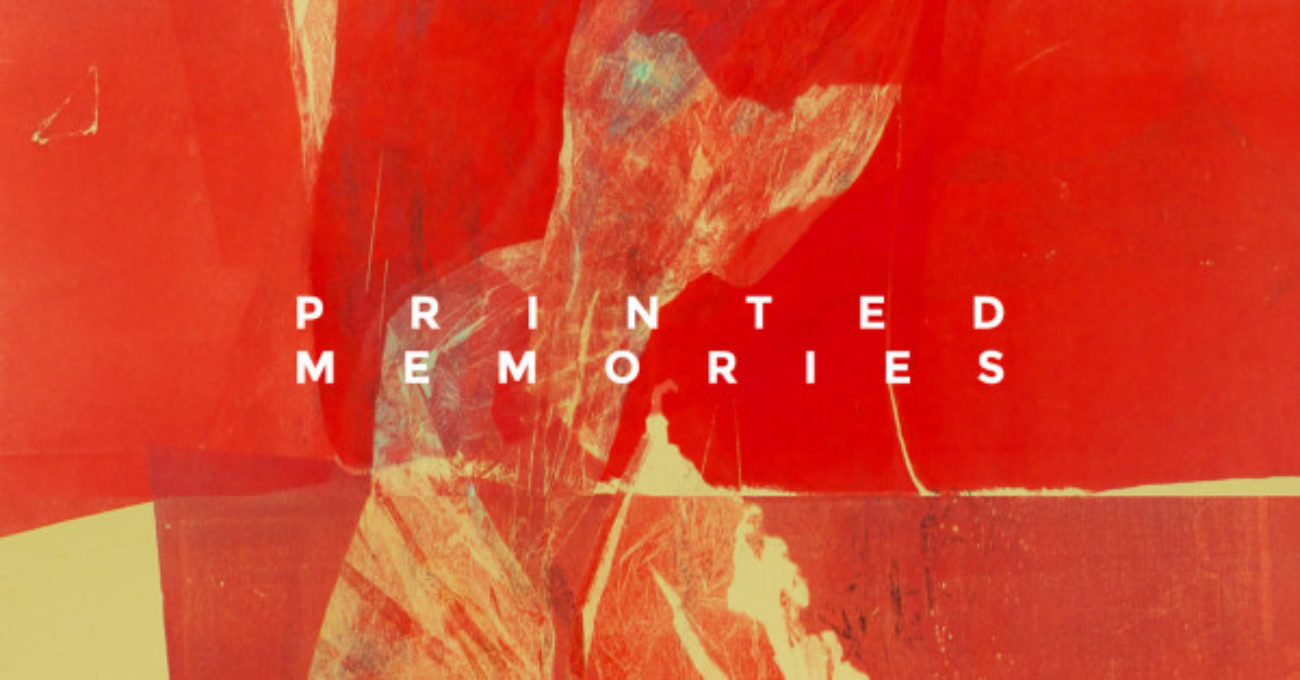
The borderland has proved a worthy muse for many artists seeking inspiration from its peaks and valleys. “The mountains have taught me about line and depth. The desert landscape and its connection with the sky have taught me about space and relationships with color,” says Jason Lucero, a borderland printmaker showcasing at the Art Avenue Gallery this month. Printmaking, more than just paint on a canvas, allows for the artist to make a piece of art through the use of different structured, shaped, and textured objects flowing through a printing press layer after layer. Due to this process, the finished product cannot be duplicated—A literal one-of-a-kind creation.
Lucero’s exhibit, Various Interpretations of Human Interaction, contains 13 monotype prints. Working intuitively, drawing from within and letting the creativity flow outward rather than using rendered objects or visual guides, is important in Lucero’s artistic process. Using his passion as a therapeutic outlet, printmaking has allowed him to bring light and understanding to some dark times in his life. “Even though I am now content, I tend to channel the sad and painful memories when I work, because, as cliché as it may sound, it is therapy,” shares Lucero. “I become a few grams lighter when I go to these dark places and transform them into color. From different work experiences, the loss of dear loved ones, and the birth of his son, Lucero says, “I have a large memory inventory, both shallow and deep, in order to keep my art interesting.”
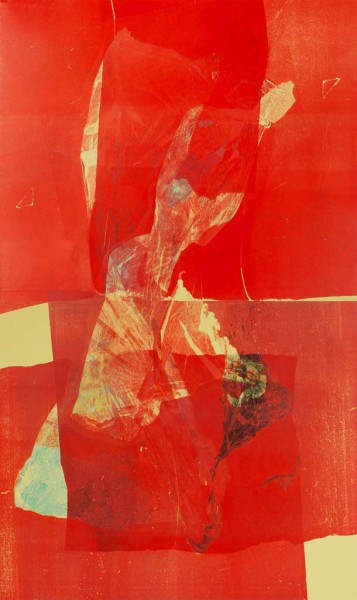
For Lucero, a great satisfaction comes from knowing he started with just a couple of friends in a grassroots artistic movement in downtown El Paso. “You have to remember this was before there were any galleries downtown; we would just walk into small places and ask ‘hey can we show some art here?’ All we wanted was to share our artwork with the city.”
While he has always had a passion for the creative arts, Lucero shared that it did not come naturally for him, which, he says, is a common misconception about artists. “Most artists aren’t born with any artistic talent, you have to practice the same strokes and lines over and over and dedicate yourself.” Lucero’s passion is art by monotype printmaking, although he is also an experienced abstract painter and sketch artist specializing in the human form. To all who will view his pieces, Lucero stresses that in order to truly appreciate them, one must realize there is a reason why they put the word ‘work’ at the end of art, “I’ve always been a businessman by day and an artist by night.” Odd jobs all over the map from janitorial services and washing dishes to working as a broker and in the transportation industry have all given Lucero opportunities to create relationships that he finds valuable to his artwork. “If you don’t take pride in your work, whatever it might be, sweeping, dishwashing, cooking, painting, or driving a rig, you will never be happy at your job and the other parts of your life will suffer,” says Lucero. He also explains that unlike in other genres of art, “More than 70% of the time my print is a failure, but I always remember these mistakes create a foundation for my success,” says Lucero.
Lucero credits his family, his friends and fellow members of Maintain (a creative coalition) the many mentors he encountered while earning his BFA in Studio Art from UTEP, and the city of El Paso for helping him realize his strengths to become a well rounded artist. “Everything about this city and its location has had an effect on me. The people of El Paso, are kind, courteous, and giving, which has taught me how to do the same.” Of his exhibition Lucero says, “My vision for this exhibition is to share a series of prints, which made me very excited about the process of printmaking, with an audience that may not be too familiar with the process. I hope that, even if people do not entirely understand what is going on in a piece, they examine it long enough to find something about it that relates to their own experience.”
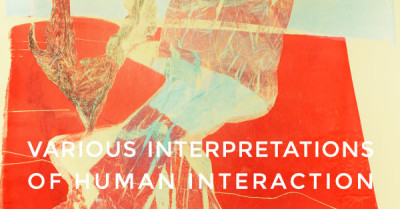 Various Interpretations of Human Interaction
Various Interpretations of Human Interaction
Jason Lucero
On Display
August 20–September 20
The Art Avenue Gallery
1618 Texas Ave, Suite E
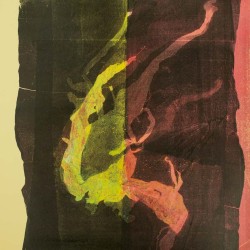
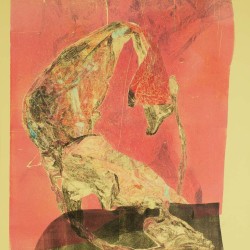
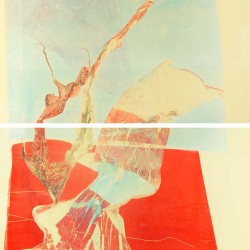
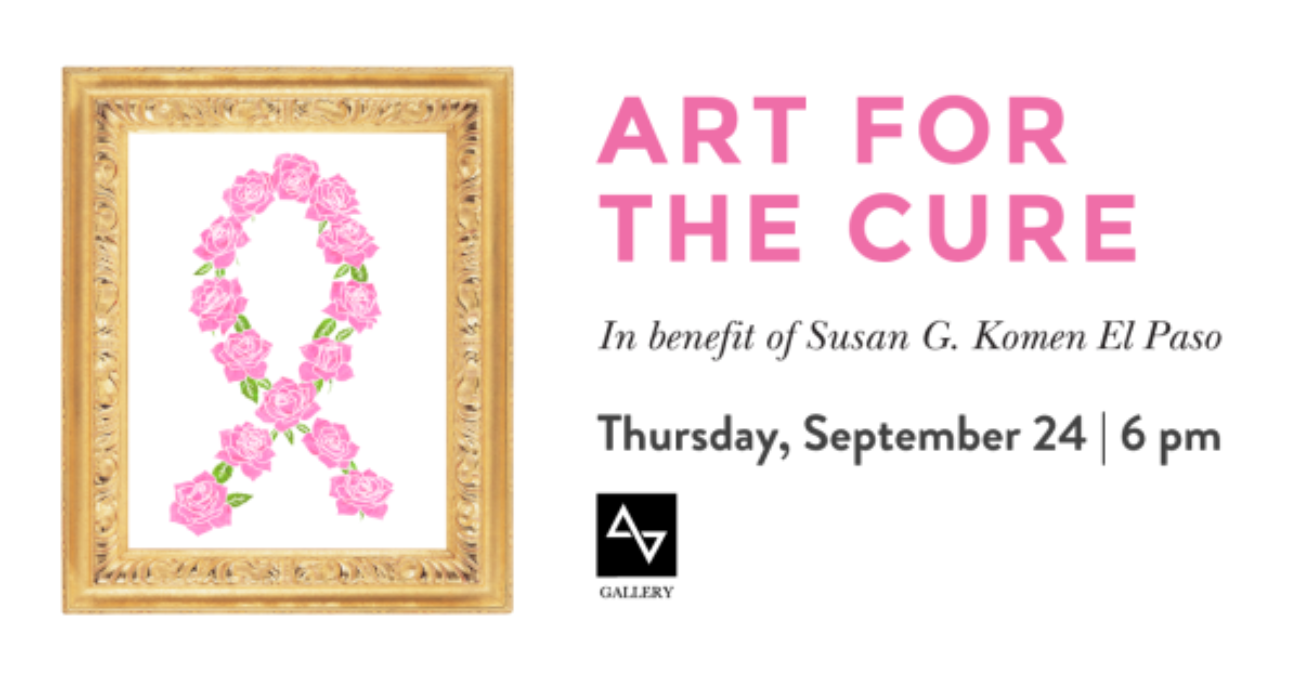
The season of giving kicks off with an evening of regional art to benefit local breast cancer charity
Thursday, Sept. 24, 2015 at 6 p.m.
El Paso, TX—Borderland artists are coming together this fall to donate their work for a night of fun and fundraising for the local Susan G. Komen El Paso affiliate. Art for the Cure, held on Sept. 24 at The Art Avenue Gallery, features a range of artwork from paintings and pottery to jewelry and bronze sculptures.
The event, which features innovative works from some of the region’s most buzzworthy artists, kicks off with a silent auction at 6 p.m., accompanied by live music, catering from Joe Vinny & Bronson’s Bohemian Café, Skinny Girl Wine and desserts from Bake Me Happy. Miss El Paso’s Outstanding Teen Haley Olivares and Miss El Paso Texas Latina Ana Avila will be in attendance as ambassadors to the arts, and Mattress Firm owner Dan Longoria will present the charity with a $15,000 check.
Organizers hope to spin the event into an annual affair, with proceeds benefiting the Susan G. Komen El Paso affiliate. According to SGKEP, the organization has allotted $4.4 million to the local community over the last decade.
Some of the artists featured include Rachelle Thiewes, Margarita Cabrera, Hal Marcus, Tino Ortega, Brian Wancho, Erin Galvez, Michael Garcia, Julio Sanchez de Alba, Diego Martinez, Sammy Lopez, Mark Paulda, Juan Ornelas, Laura Pablos, Jorge Calleja, Mike Ojinaga, Reggie Waterson, Lula Squid and Jim Turrentine. The event is sponsored by Skinny Girl Wine, Joe Vinny & Bronson’s Bohemian Café, Mom’s Fresh Juice, The Art Avenue Magazine and The Art Avenue Gallery.
“I decided to create the event to do something different in terms of fundraising and to help keep things local,” said Komen board member, Kimberly Rene’ Vanecek, who also owns The Art Avenue Gallery. “So often we see national organizations benefit instead of the local chapters, so this is an important organization that gives back locally.”
“Our local and surrounding communities are fortunate to have such talented artists in ourarea and to Ms. Vanecek for providing this forum. We could not be more proud to have such an array of artists come together to support an event of this caliber,” – Raquel Markland, Susan G. Komen El Paso board president.
Event Details:
Date: Thursday, September 24, 2015
Time: 6 p.m.
Where: The Art Avenue Gallery 1618 Texas Ave. Suite E
Cost: $25
Tickets can be purchased at theartave.com, by calling 915.213.4318, or at the door.
[themify_button style=”large flat pink rect” link=”http://theartavenue.lapaginadejorgecalleja.net/wp/shop/event-tickets/art-for-the-cure-event-ticket/” target=”_blank” ]Buy Tickets[/themify_button]

For each issue of Art Avenue, we’ll highlight a speaker from the 2015 TEDxElPaso conference, which was held at the El Paso Community Foundation Room in May. An independently organized event, TEDxElPaso continues the national non-profit TED’s mission to share “ideas worth spreading.”
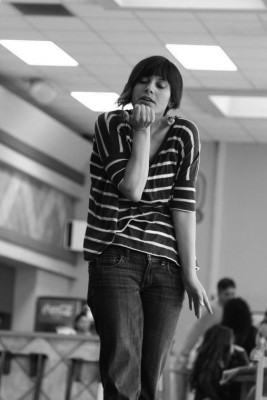
At May’s TEDxElPaso conference, guest speaker Sandra Paola López prompted an audience of over 100 to introduce themselves to one another. The task was simple enough, or so it seemed.
“But before we start, I’m going to give you a performance direction,” López continued. “We’re going to do this in gibberish.”
Audience members shifted uncomfortably in their seats inside the El Paso Community Foundation Room, but what started off as shy mumbles evolved into a crescendo of made-up languages and, eventually, laughter.
“So what just happened?” López asked. “We took a very ordinary activity, something we do on a regular basis, but we changed how we did it. You transformed the energy of the room.”
This exercise, she later said, is an example of the message in her speech “Performance Activism: How You Can Change the World Without Changing What You Are Doing.”
By agreeing to participate in López’ task to introduce themselves to one another in gibberish, López said the audience members left their comfort zones and therefore opened up new possibilities.
“We cannot create change unless we are ready to do things we do not know how to do,” she explained. “The power of doing things like that is that it really breaks those hierarchical positions and it puts us all in an even playing field to create different kinds of relationships.”
This is a lesson López said she learned in her career as a multidisciplinary dancer. While at first she questioned her impact as a performer, she instead decided to focus on the process of her art and learned that in order for social change to be possible, people must leave their comfort zones.
A native of Colombia, López has been dancing since she was 4 years old, perfecting her techniques in ballet, jazz, tap, modern and traditional Columbian dance. After earning a bachelor’s degree in Dance Performance at Missouri State University and a master’s degree in Curriculum and Instruction at the University of Illinois at Urbana-Champaign, she learned about dance improvisation through a New York collective called Lower Left in 2009.
“Getting into improvisation in dance started opening my eyes to different ways of relating to my body, different ways of relating to movement, different ways of relating to other bodies in space when I was dancing,” López said. “I’m finding the kind of power that it has for me.”
Improvisation also helped López open up to new methods of performing and teaching, she said. The next year, she learned about performance activism while obtaining a certificate in social therapeutics at the East Side Institute for Group and Short Term Psychotherapy in New York.
The specific concept of performance activism López learned about was developed by the institute’s co-founder Fred Newman in the 1970s as a grassroots movement led by him and his colleagues. It suggests that the world is a collection of “stages” and that we, the “performers,” both improvise and write countless “scenes” in our lives.
As an instructor at the University of Texas at El Paso and New Mexico State University, López said she encourages new forms of interaction by allowing her students to help decide what will be discussed in classes. Through her organization in2improv, López promotes performance activism by challenging people of all ages to try collaborative improvisation.
“But when I talk about performance activism, I’m not talking about my dance career,” López said. “I’m referring to the quality of the activity that you’re doing. You could be a performance activist and be an engineer, an economist or a lawyer or a doctor and that’s where I think the power of performance activism lies.”
Performance activism takes place when we shake things up and decide to do things differently, challenging our everyday behavior and thought processes, López said.
“When my partner and I are having a disagreement, we can both step back and say, okay, let’s perform this argument in a different way so that we don’t fall into the usual patterns of becoming a victim and pointing the finger at the other person,” López said.
Lopez said such activism can be applied not only to social settings or professional relationships, but to relationships between loved ones as well.
“Another example is a mother and a child,” López said. “The child comes to the mom and says, ‘Mom, there are monsters in my closet.’ Maybe our go-to place would be to say, ‘Oh, don’t be silly. There’s no such thing.’
“But another performance would be saying, ‘Oh my gosh, let’s go find him!’ and then you create this this whole thing with the child to have a different relationship with the fear of having monsters in the closet.”
López’ approach to education and activism seemed so unique to community outreach organization Philosophic Systems Institute founder Juan Ferret that he introduced her to El Paso Community Foundation president Eric Pearson after she moved to the Sun City in August of last year. Along with Chris Cummings, executive vice president of real estate company CIC Limited, the foundation organizes TEDxElPaso to contribute to TED’s mission and share “ideas worth spreading.”
When Pearson asked if she would be interested speaking at the conference—she knew it would be her chance to expand her outreach in a new way.
“I felt very connected and transformed through a lot of TED Talks that I’ve seen, so I really think that you can have a big impact to talk with that platform,” López said. “It’s a great opportunity to not only reach people locally through the conference itself, but also to reach a broader community internationally.”
Aside from the fact that López has listened to countless talks covering technology, entertainment and design (hence the abbreviation TED), her other connection to the organization also lies in the fact that her brother Carloz López previously gave a talk called “Asombremos con sonrisas,” which explored the power of making people smile, for TEDxLasAguas.
It didn’t take long for López to decide that she wanted to share her profound passion for performance activism with her audience.
“Everyday, take a step to get out of your comfort zone,” López said in her last remarks at the conference. “After five years of doing this work, I have realized that I still don’t know what I’m doing and that if I’m lucky, I never will.”
[themify_col grid=”2-1 first”][themify_box style=”red” ]Learn more about TEDxElPaso at TEDxElPaso.com. To learn more about Sandra Paola López, visit SandraPaolaLopez.com.[/themify_box][/themify_col]

Tracey Jerome challenges gender inequality in the art world by holding two director positions, normally held by men.
Jerome defied the good old boys club when she flew into town this February and set out to strive for excellence in the arts not just as director of the Museum of Culture Affairs Department but also interim director of the El Paso Museum of Art after Michael Tomar’s leave that same month. Heels on the ground she arrived from London where she was a gallery director after receiving her MA in History of Art from Sotheby’s Institute of Art.
VANECEK: Do you think there is an advantage as the director of MCAD and having immediate accessibility with the EPMA? Do you feel it allows you the ability to mainstream issues?
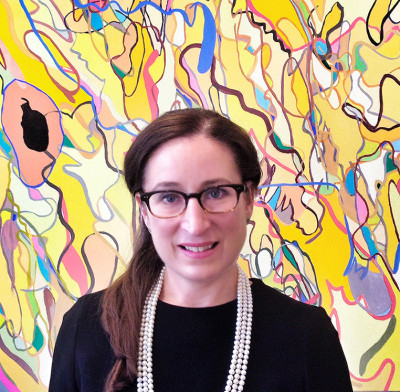
JEROME: Absolutely, it’s not just a matter of mainstreaming, it’s a matter of actually understanding the institution of art in a more intimate way and helping to understand that my vision and the bigger picture will work across all of the sites. I think in the past what has happened—and again this isn’t a criticism, but this is one of the reasons I was brought in—was collaboration and integration across all of the sites is something in getting a unified message across of what we are doing.
From a cultural and artistic standpoint this community is incredible—which is what drew me here initially. I think one of the biggest, challenges that we face though is getting the message out. I think people know the name El Paso, but they know absolutely nothing about anything about the community and they certainly don’t know about the creative and artistic community here. This is a vibrant and artistic community—a very special, very special place and I want to get that message out.
KRV: How do you propose doing that—getting the message out?
TJ: I think commitment to quality and excellence in everything that we are doing is something that I am completely committed to and ensure that it’s not just good enough or fine, but that we are striving for excellence in everything we do.
Making sure we are communicating what we are doing and sharing it. It is really important and not being afraid to reach out and have people say ‘Hey, you need to look at what we are doing.’ We are getting that type of coverage from the public art program. For example we have been written up in a very positive light [in] Dwell magazine. They did an article on the steel installation pieces at the Brio entitled “Leaves of Air” by Catherine Widgery and the airway project has been noted and very positively received on the national front.
The museum as well—we now have the second largest collection of retablos [Mexican folk art devotional paintings that heavily reference traditional Catholic church art] in the world and we are getting ready to celebrate that in a bigger way than has been done in the past.
KRV: What specifically would you like to see happen with the collection of retablos at the museum?
TJ: There has always been a committed niche but I have been working very close with my curatorial team and we are going to have a much bigger, broader expansion of an exhibition through a gift we have received recently. There will be a smaller publication—we will start with that and then I am very keen to have a larger catalog that will be published. What I would also like to see happen is a larger, more comprehensive exhibition that can tour nationally and perhaps internationally.
By the way, I don’t believe in no’s or don’ts, I believe in do’s. For example at the museum of art you won’t see a “Do Not” sign, I removed those when I came in, I had all those removed. What you will see for example, in our museum school section are signs up that will tell you about things like “Please Do.” I know it sounds like a small message, but the messaging is very powerful. I think it’s really important for people to realize that all of these assets and all of these facilities belong to us, to them and the community.
KRV: Your arrival this February coincided with the opening of the digital wall at the Museum of History. How have you managed this new project that you oversee?
TJ: The digital wall is receiving a lot of attention. I would like to see that enhanced…because I don’t think anyone understands how profound that asset is. We are talking tens of thousands of visitors. We have over 5 million [interactive] touches since February 14, 2015, and what that tells us about the experience that people are having is that they are not just touching the wall once or twice, they are touching and going very deep. It’s an organic asset because it’s constantly expanding and growing and anyone can be a part of that and anyone can upload images and we encourage everyone to take part in that and upload their piece of the history.
KRV: You mentioned collaborating on a greater scale in the art world, can you expand on that vision?
TJ: There is a great demonstration of collaboration across the sites across the department because we also have a piece of public art that was installed there [at the digital wall] so when you step into the pavilion, you are not just experiencing the high tech digital wall but you can also experience this amazing public art piece.
You can come into the downtown now and there is the museum of art and then you can walk up to the Museum of History and encounter the digital wall. You can walk across the street and take a little stroll down the pedestrian pathway and you have a piece of public art by Matthew Gellar you have the incredible murals that have been done by Creative Kids at oLo Gallery, and then again you continue on down the pathway and you have the great piñatas by Steven Engel.
I am very passionate about the idea and a concept that art is not the icing, it’s an integral ingredient to what is happening in economic redevelopment for the economic vibrancy in a community. You have companies, corporations and individuals that are looking into relocating and what they want to know about is: are there good roads, good hospitals and good schools? But what they really want to know is what is our quality of life going to be? And if that is not there—museums and art are a great energy, then we won’t get them.
KRV: I agree that sometimes the great artistic contributions go unnoticed. Do you have a strategic outline for promoting upcoming projects? You mentioned you had 41 projects completed and 22 on the drawing board in various stages.
TJ: Our program here is not just committed to the downtown but we have public art programs going on throughout all of the districts. The way public art works is that the community is invited to be involved in the whole process. At the first meeting we took visuals to talk to them and where we were going to put [the public art piece] in the district. So we actually work with the community and discuss the various types of art we can place and then they were giving the opportunity again to place stickers (on locations to place art in their district) and they could go and choose what they wanted to have and everybody was really happy.
I don’t think people realize we are the number one funder for the creative community here in the city. About 25% of our budget goes directly back into the community through grant funding programs. This is something that I find really powerful because it’s a huge support for the arts community.
KRV: How much then is 25% of the budget allotted for granting purposes?
TJ: MCAD will grant a total of $409,000 in Fiscal Year 2015 to the creative community in El Paso.
KRV: For your role as director at MCAD what specifically would you like this department to do?
TJ: First and foremost what I want to do is function at a level of excellence. I want people to be looking at our community and going, ‘That’s what we should be doing.’ ‘We want to be like them.’ ‘We want to be like El Paso.’ I don’t want El Paso to feel like they need to be like anybody else. I am working very hard on a lot more integration and we are much stronger when we are together and so there could be something going on at the farmers market that ties into the public art that ties into the exhibition and activities that are happening at the museum. It shouldn’t be separate, it should be more integrated.
And then externally I am reaching out, as is my team, to work across the community because collaboration is so important. For example with this year there was TEDx. There was collaboration with that event and we are looking to expand that next year.
The EPMA has a big collaboration with the Plaza Classic Film Festival. We are going to have a coordinated exhibition and activity schedule planned with the El Paso Community Foundation (sponsor for the Plaza Classic Film Festival) to do a whole focus on Warhol’s world. We’ve secured in working with the Community Foundation the loans of a number of 16mm films by Warhol from MOMA in New York. We are going to be showing Warhol films and we have secured a small collection of Polaroids that were gifted to the Museum of Art by the Warhol Foundation and we are going to be exhibiting those. We are going to have silk screeners on site where we are going to be creating art people can experience.
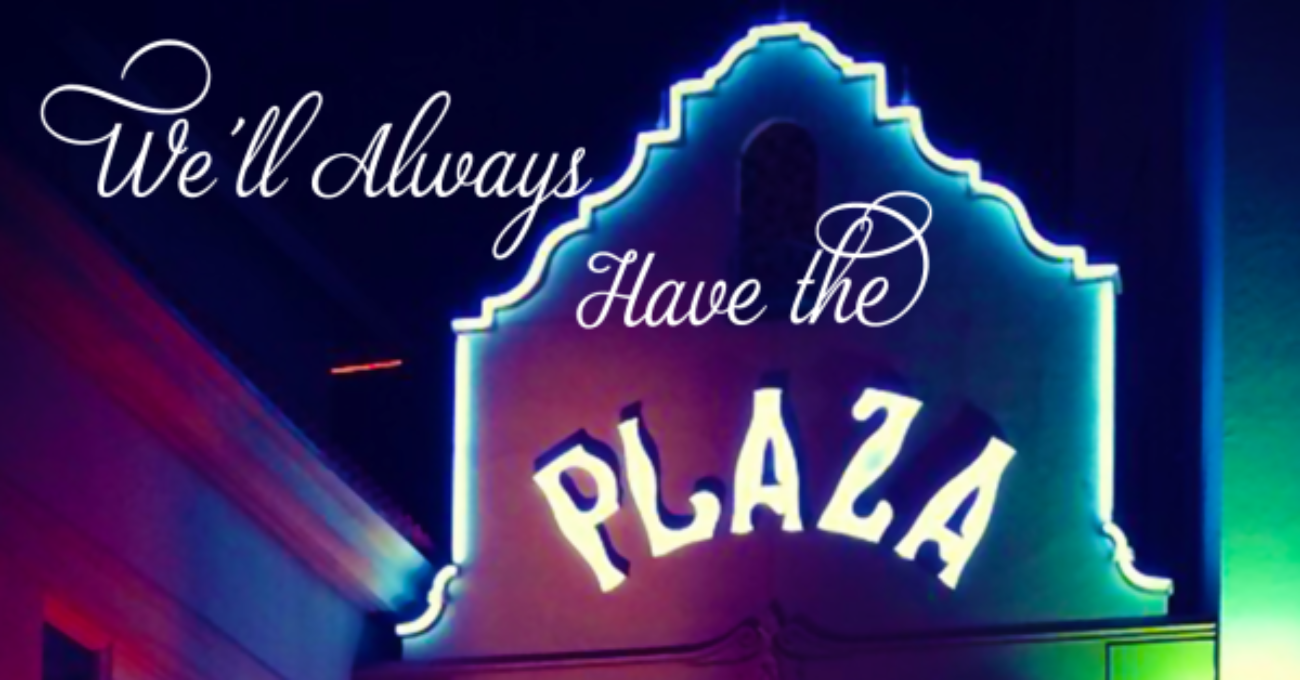
Frankly my dear, the Plaza Classic Film Festival is the largest in the world, and for El Pasoans who understand and appreciate the legacy of the Plaza Theatre they know there’s no place like home to watch some of the most treasured films in history. “There’s something about watching a movie in a theater, surrounded by people who can collectively become a living, sentient being that applauds the heroine, laughs when it’s supposed to and cries when the movie touches its heart,” says Eric Pearson, president of the El Paso Community Foundation. This classic film festival acts as an aide-memoire to the Plaza Theatre in its heyday when it was a first-run movie theater showing the likes of Casablanca and The Wizard of Oz.
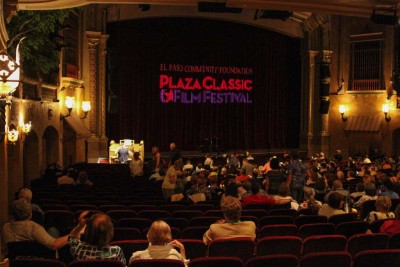
This year, the El Paso Community Foundation has partnered with The El Paso Museum of History to bring the exhibition Frankly My Dear: The Art and Impact of ‘Gone With the Wind’ debuting on July 23. Also, for the fifth straight year, the foundation is teaming up with the El Paso Museum of Art, this time featuring a series of Andy Warhol’s experimental films and Polaroid’s entitled Warhol’s World: Film Screenings and An Art Installation, which will run from August 4 through the 16. In addition, the Plaza Classic Film Festival will feature more than 20 hours of film produced here locally in the borderland.
Every year, the festival features regional bands and artists as well as lectures and book signings by local scholars and authors to ensure everyone finds their niche at the festival. Several new events this summer promise to add more zest and excitement to the festival for young movie lovers in the borderland. Summer Film Camp, taking place August 3 through the 14, will teach youngsters aged 9 to 13 basic skills in film making and cinematography. At the conclusion of the camp, these short films will screen at the Plaza. Throughout the festival, there will be outdoor film screenings cast onto giant inflatable screens for both movie aficionados and newbies of all ages to enjoy all around the historical downtown El Paso area. A special showing of The Natural, a baseball classic from the early 1980s, will also debut on the state-of-the-art HD scoreboard at Southwest University Park, home of the El Paso Chihuahuas.
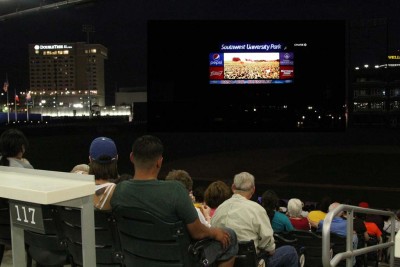
With all these different events, shows, and films, as one would imagine, it takes hundreds of local volunteers, actors, business owners, and the dedicated team at the El Paso Community Foundation to have a successful festival. “Without all of these people, there would be no festival,” says Doug Pullen, program director for the festival.
“Movies are like time capsules, speaking of the times in which they are made,” says Pullen. “Not only do young people get a chance to see great movies and movie stars from bygone eras, but they get to see how Hollywood wanted us to think or feel about a subject, person or issue. It’s history.” It’s no secret that through many films, especially those that debuted during times of war, that propaganda was spread through the theater. Many classic films contain priceless historical clues and references carefully and artfully woven into the stories. Pearson reminds us that, “the term ‘classic’ really means that the movie had a lasting cultural impact.” These classic films hold a special place, not only in history, but in the hearts of those who watch them. Every year this festival makes us laugh, stirs up wonder, and helps us remember that, although we may not always have Paris, we’ll always have the Plaza Theatre.

Photos by Bernie Maese; Hawk and Hero Productions
Hair & Makeup by Heather Deshea Harrison
Styling by Edwardo Herrera
Wardrobe by ARMOIRE
The art world is populated with an overwhelmingly large male presence, yet locally there is a collective of women who are taking strides to help promote, create and protect the arts in the El Paso region.
In the first of a series of articles, The Art Avenue Magazine sets out to highlight women who are breaking down barriers in the art community by way of philanthropists, professors and promoters helping to recognize and protect the rights of quality artists in the region.
[themify_hr color=”pink” width=”50%” border_width=”2px” ]
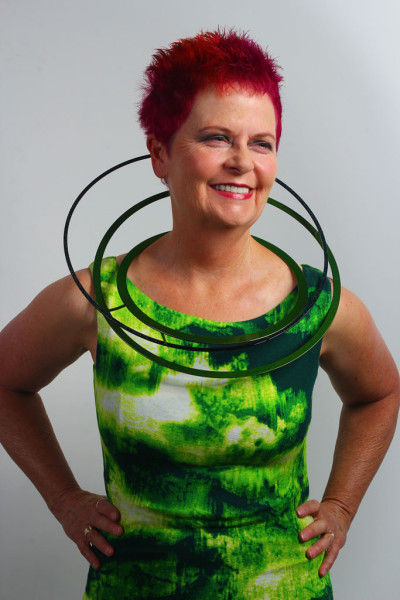
Rachelle Thiewes was featured in The Art Avenue issue “Play” in May 2014 is an artist working in jewelry design and a former UTEP art professor, says it is difficult for contemporary artists to gain local recognition but urges them to keep trying, “If you want to get beyond local you have to be fearless, you have to bang on doors.” Thiewes credits her artistic success to her parents, who were both artists. “My dad was a master hand engraver and my mom was a designer and seamstress. They taught (me) to see artists as one, not female versus male.” She admits she has had great success in her career, but it’s hard for her to articulate that to others. “I think I’ve had great things happen. I’ve been published in many books and my work is exhibited (in) galleries on an international level, but I’ve worked really hard.” Working hard consisted of countless hours either in her studio at home creating new and innovative pieces or teaching students at UTEP. She says there was a continuous rhythm to her climb to the top. Now retired, Thiewes was passionately devoted for 37 years in her position as head of the metals program in the art department at UTEP. As a professor she admits she wanted to change things up a bit, “I wanted the students to come to school because something good was happing. I wanted to interest them and challenge them.” Thiewes encourages artists to do their research and find out where they belong…where there art belongs. She highly suggests engaging them in the regional art scene and always follow up on someone that has purchased your art. She currently has work in The Smithsonian in Washington, D.C., an exhibit in the Gold Museum in Taipei and an upcoming show in Boone, South Carolina.
[themify_hr color=”pink” width=”50%” border_width=”2px” ]
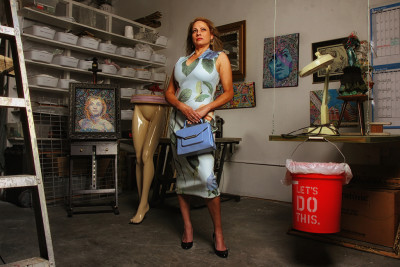
Attorney Kathleen Hope Crook left the Department of Commerce in Baltimore last year and returned to El Paso specializing in business asset protection, intellectual property, privacy and data security. She has established her own law firm with a passion for protecting the rights of musicians and artists. “Common errors most artists do is give away their work and not understanding the full value of their work,” said Crook. She enjoys helping artists protect their work by encouraging them to copyright it. “The first step is to register it with a copyright office and photograph it. Keep a record of all your work.” Crook continues, “If something were to happen to you, you need a contingency plan. Who gets your work?” She says artists and musicians should treat their work as a business and it needs to be protected, “I’ve helped musicians get out of contracts because they didn’t know what they were signing.”
[themify_hr color=”pink” width=”50%” border_width=”2px” ]
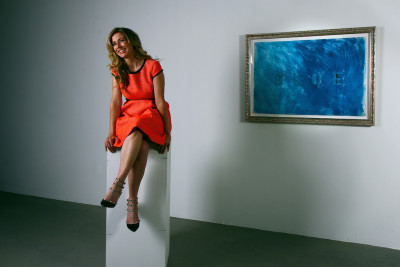
“Right after I graduated from Southern Methodist University with a degree in art history I returned to El Paso and attended an exhibition at the Mexican consul. This was the first time I purchased a piece of art—I bought two pieces (Oaxacan style art) and befriended the curator of the exhibition,” said Isha Rogers, local philanthropist. This would be the start of a long and loving relationship with the art world, specifically her involvement on a regional level. Rogers is a text book definition of what a philanthropist is—she has been a board member of the previous Bridge of Contemporary Arts, and is currently involved in Texas Women in the Arts, sponsors the Isha Rogers Sculpture Gallery at the El Paso Museum of Art and is instrumental in supporting performance arts, specifically the El Paso Opera. “I went to the opera a lot with my mom when I was growing up, so I hope she would be proud,” said Rogers. Some of the artists currently hung in her home include Manuel Acosta, Suzi Davidoff, Coleen Drake, Gaspar Enriquez, Diego Martinez and Rachelle Thiewes.
[themify_hr color=”pink” width=”50%” border_width=”2px” ]
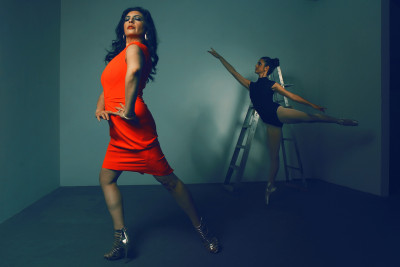
The El Paso City Ballet artistic director, Lisa Marie Skaf, has two feet that don’t stay still. If she isn’t performing a piece from her favorite composer, she is busy promoting performances in El Paso. Skaf, a graduate of Loretto Academy, has spent the last five years blazing trails through downtown El Paso speaking with sponsors, event organizers and performance art lovers in hopes of garnering enough attention to introduce the arts on a level to which this community has not encountered. Her last endeavor, Ballets with a Twist, had The Plaza Theatre packed with guests interested in an innovative take on ballet.
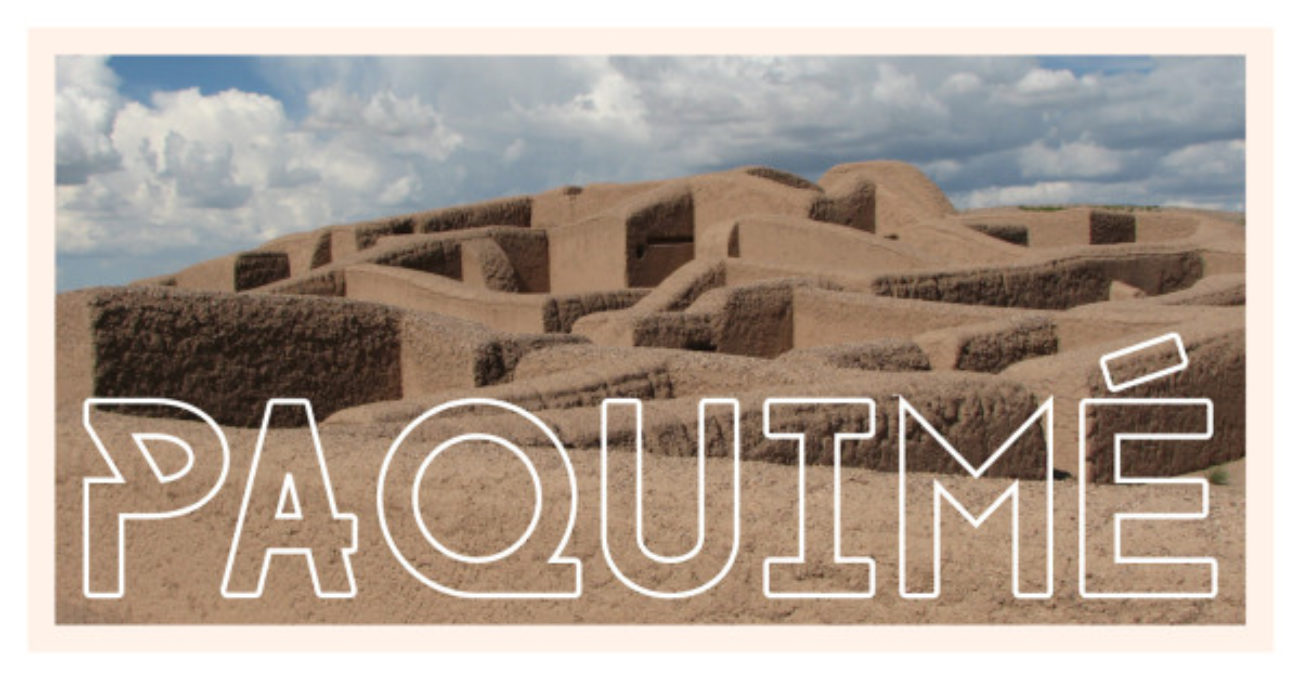
One of my favorite subjects to photograph are the ancient ruins of Paquimé (Casas Grandes) located in Chihuahua, Mexico. I grew up a few miles from this site and have always been fascinated by it.
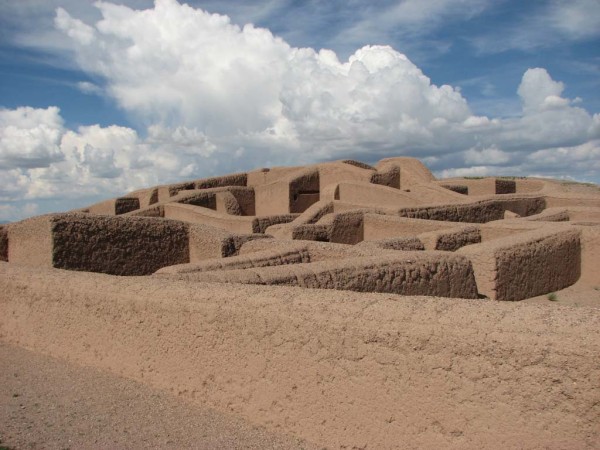
The Casas Grandes Culture inhabited parts of Chihuahua, Sonora, and New Mexico between 700 AD – 1600 AD. During the Medio Period (1200 AD – 1450 AD) the Casas Grandes Culture reached the height of its prominence and influence in the region. It is during this period that Paquimé was built and served as an important ceremonial and trade center. The largest cache of shells ever found in an archaeological context in North America was excavated at Paquimé. Exquisite ceramics, beautiful works in stone, copper bells, turquoise, and macaw remains were also found at the site. Paquimé was declared a UNESCO World Heritage Site in 1998.
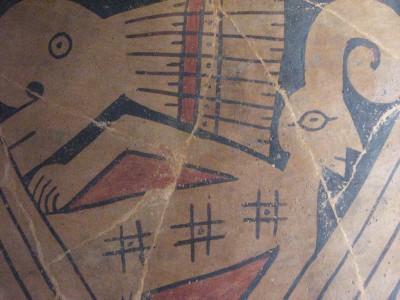
This pot, and many other artifacts excavated at Paquimé, can be seen at the museum located on-site at the ruins.
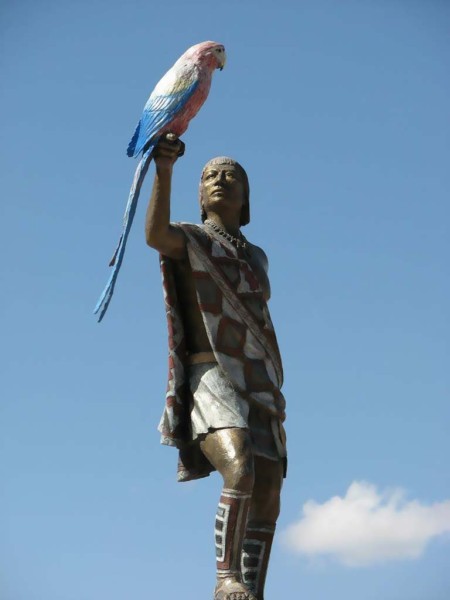
Vladimir Alvarado’s bronze statue (pictured above, Monumento a la Raza Paquimeita, 2007) can be seen on the main highway as you drive into Casas Grandes, Chihuahua, Mexico. The ruins of Paquimé are located just outside this town, which was named after the ruins (Casas Grandes meaning “Big Houses.”)
Words and photographs by Jeff Romney